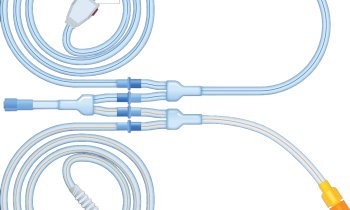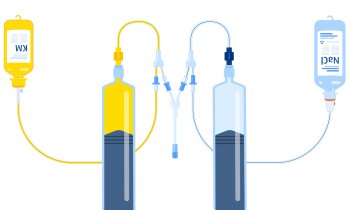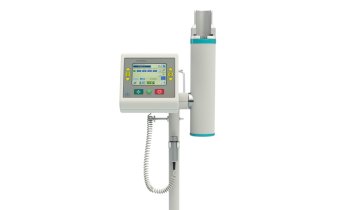Current issues in contrast media administration - gadolinium compounds et alii*
Already in 1993, the world market for contrast media was thought to be worth $ 3 billion. In 2001, an astonishing 12.2 million contrast medium-supported CT studies were carried out in Europe alone. Currently, the overall sales of contrast media are estimated to rise to $ 915 million in Europe in 2008.

In its history, the market has seen two major developments, firstly the switch from hyper- to low-osmolar iodinated agents in the late 1980s and, secondly, the widespread introduction of MRI contrast agents in the 1990s. The former occurred after cost considerations on the initially considerably more expensive low-osmolar agents changed. The latter largely accounts for the reduction in the market share of iodinated contrast media sales from 91.7 % in 1992 (world; non-ionic agents) to projected 60.7 % (Europe) in 2008. While many more compounds have since been approved for use in the various imaging modalities, with the exception of the advent of ultrasound agents in Europe in 1991, these are largely for use in specialist or research applications such as intra-vascular (blood-pool) or tissue-specific (targeted) imaging, e.g. use of ultra-small super-paramagnetic iron oxide (USPIO) in the detection of vulnerable atheromatous carotid plaque or SPIO-linked monoclonal antibody against endothelial cell surface molecule PE-CAM-1 as a ‘memory agent’ for ischaemia in unstable angina.
Given such frequent use, contrast media may not be discussed without reference to adverse events. These have previously been expertly discussed by Whitehouse and Worthington as well as Chapman and Nakielny. Recent reviews of the occurrence of serious adverse events with the use of low-osmolar iodinated (literature review) and gadolinium-based (manufacturer’s database) contrast media indicate frequencies of ≤ 4 % and 0.01 % of procedures respectively.
This review aims to discuss topical issues in contrast media-usage with reference to serious adverse reactions and their prevention, particularly highlighting the risk of nephrogenic systemic fibrosis with the use of gadodiamide in patients with end-stage renal failure.
Nephrogenic systemic fibrosis
Gadopentate dimeglumine, the first paramagnetic contrast agent on the market has an excellent safety record, as indicated above. Even the earliest post-market study, which included 15 thousand (adult) patients and a group of 655 patients under the age of 20, found no more than a 2.4 % frequency of headache, nausea or other minor reaction, with only 1.7 % minor adverse events in the paediatric arm. At present, eight gadolinium-containing contrast agents are licensed for use in the UK; five compounds carry FDA-approval. While these compounds are generally safe, there is a recognised morbidity associated with their use, anaphylactoid reactions do occur and some of these are severe: A 1996 review of the use of gadolinium-based agents in 21 thousand patients at a single academic institution revealed severe anaphylactoid reactions in 0.01 % of cases, a finding that has since been validated by other authors. In January 2006, a previously unrecognised aetiological connection was suggested between the development of nephrogenic fibrosing dermopathy, today referred to as nephrogenic systemic fibrosis (NSF), and the administration of gadodiamide during MRI scanning. This notion has received much attention since, starting with an FDA-warning in June 2006 and culminating in multiple editorials in radiological journals (Clin Radiol, Br J Radiol, Radiology, Eur Radiol) and advice from professional bodies in 2007 (European Pharmacovigilance Working Party, Austrian Chamber of Pharmacists, Am Coll Radiol). Irrespectively of these warnings, many in the radiological community are unaware of the issue.
NSF is a scleroderma-like condition that may develop in patients with chronic renal failure, usually end-stage renal failure (ESRF) requiring replacement therapy. There have been a few instances of NSF in patients with apparently moderate renal impairment based on glomerular filtration rate measurements, but at least some of these cases involved additional acute-on-chronic renal injury when GFR estimation may be inaccurate. The predominant and disabling manifestation of NSF is cutaneous through increased deposition of collagen, potentially leading to flexion contractures. Importantly, however, parenchymal organs may also be involved and deaths have been recorded. A proportion of approximately 5 % of affected individuals exhibit a rapidly progressive course. NSF may stabilise but rarely spontaneously remits and there is no consistently effective therapy although a rapid correction of renal function may result in reversal of symptoms. The initial report focussed on five out of a cohort of nine patients with ESRF who were subjected to gadodiamide-enhanced MRI. These five individuals developed NSF within weeks of contrast medium administration. Some 200 such cases have been recorded over the past year, the majority related to the use of gadodiamide and gadoversetamide. At least six cases, however, have been associated with gadopentate dimeglumine, but may be attributable to the administration of multiple and/or high doses. The overall risk for the development of NSF following gadolinium administration in the context of advanced renal disease may be between 3 % and 5 %.
The development of NSF, i.e. the induction of fibrosis may be related to the presence of extremely toxic free gadolinium ions secondary to a process of transmetallation between the paramagnetic heavy metal bound to a chelating agent and endogenous ions, consistent with different stability between the various commercially available gadolinium-compounds. Delayed excretion of principally renally eliminated gadolinium contrast media in ESRF precipitates the problem, presumably by generating a critical tissue exposure. This hypothesis is supported by the observation that Gadolinium is detectable in biopsies of NSF-affected skin.
Nevertheless, there are two observations which suggest that gadolinium compounds may be ‘a necessary but not a sufficient cause of NSF’: 1. several cases of NSF had a documented earlier exposure to gadodiamide without consequent development of signs of the disease within the reported interval of 2-75 days. 2. NSF may also occur in patients without a documented exposure to gadolinium compounds.
Contrast-induced nephropathy
As with NSF, contrast-induced nephropathy (CIN) occurs in the context of chronic renal impairment. Intravascular, particularly suprarenal administration of iodinated contrast media cause a deterioration in renal function as indicated by an absolute or proportional rise over baseline, the latter commonly considered when ≥ 25 %. CIN is thought to occur through a reduction in renal perfusion via a direct effect of the contrast agent through a feedback mechanism dependent upon the osmolality of the medium, i.e. less hyperosmolar agents are less likely to induce the condition. While the incidence of CIN is low in an unselected patient population, in patients with known renal impairment, it was found to range between 12 and 27 %. CIN is principally a self-limiting condition, i.e. not per se leading to persistent renal changes, but there is a high level of associated morbidity and mortality. For example in patients undergoing endovascular coronary interventions, the associated in-hospital mortality of CIN is cited as high as 22 %. Today, CIN is the third-leading cause of hospital acquired renal failure.
However, since the condition is inversely related to the glomerular filtration rate, patients at risk may be identified in advance. Appropriate questionnaires, asking for a history of kidney disease, prior renal surgery, proteinuria, hypertension, gout and, importantly, diabetes, detect 99 % of individuals with a raised serum creatinine. Such patient-related risk factors are compounded by procedural risks: the patient’s state of hydration, type, concentration and volume of contrast medium used as well as current use of nephrotoxic drugs and history of very recent contrast medium administration are all critical. Appropriate hydration even after the radiological procedure and up to 24 hours is the single most important measure that can be taken to avoid CIN. A urine output in excess of 150 ml/h is advised and, in the case of high dose or intra-arterial contrast media administration, hydration should be achieved intravenously. The use of low- or preferably iso-osmolar contrast agents is also effective. In the search for a protective pharmacological agent, no single drug has consistently been found to be of use. Specifically, there is insufficient evidence for a prophylactic effect of N-acetyl cysteine. Haemodialysis removes iodinated contrast medium but does not prevent CIN and several sessions may be needed. It may take weeks to completely eliminate the agent by peritoneal dialysis. However, while considering its invasive nature, cumbersome set-up and high costs, continuous haemofiltration is effective in preventing CIN.
One should be aware that any deterioration in renal function may not become evident clinically or through laboratory chemistry until a week after the intervention. Measuring check serum creatinine at 24 hours will certainly miss a relevant proportion of instances.
Advice regarding the prevention of CIN and its management has previously been provided by the European Society of Urogenital Radiology in their 1999 guidelines, recently reviewed by Thomsen (Nephrol Dial Transplant 2005; 20 [Suppl 1]: i18-i22).
Lactic acidosis
The oral anti-diabetic agent metformin may inhibit lactate degradation. The story of metformin (a biguanide) induced lactic acidosis is intimately linked to the occurrence of contrast induced nephropathy. A metabolic acidosis due to raised serum lactic acid may occur in severe hypoxic states such as cardiogenic shock or sepsis. In the late 1970s, a causal relation between intake of biguanides, acute renal failure and lactic acidosis was recognized as a class-effect. However, metformin does not cause renal failure, metformin and radiographic contrast agents do not interact and lactic acidosis only very rarely occurs in patients with normal serum creatinine. Nevertheless, since metformin is eliminated from the body entirely through the kidneys, any renal impairment such as in contrast induced nephropathy may lead to its accumulation.
Lactic acidosis in the context of CIN in patients with metformin-treated diabetes has an incidence of only 0.003 %, importantly however, about half of cases have a fatal outcome. Patients at risk are those who are at risk of CIN, particularly those whose renal impairment is due to their diabetic state. As indicated, there is a correlation between the degree of renal impairment and the likeliness of CIN as well as the state of hydration at the time of a contrast medium supported investigation. Irrespectively, since a normal serum creatinine does not necessarily imply normal renal function, occurrence of lactic acidosis may still ensue in such patients.
There is differing advice in various parts of the world how contrast media administration should be managed in diabetics receiving metformin: Some believe that biguanides are contraindicated in any form of renal impairment and it may be argued that metformin is an inappropriate choice of agent in the context of even mild renal impairment, however, the agent has several important advantages over other oral antidiabetics, namely improving insulin sensitivity, reducing hunger and decreasing gastro-intestinal absorption of carbohydrates while only rarely causing hypoglycaemic episodes.
In Germany, current advice still suggests that metformin is discontinued 48 hours in advance of a procedure while in the United States metformin may be stopped at the time of the investigation, providing a normal serum creatinine reading. The Royal College of Radiologists in their guidelines take the same view as the German and wider European authorities but differ in that patients who are to receive intra-arterial or doses in excess of 100 ml of contrast medium should also discontinue metformin 48 hours prior to examination, irrespective of a normal serum creatinine. There is agreement generally that metformin should only be recommenced when serum creatinine has been checked at least 48 hours post procedure and is found to be normal. Other advice relates to the prevention of CIN, specifically regarding the use of low-osmolar media and hydration.
Prophylaxis of anaphylactoid reactions
Adverse reactions to radiographic, i.e. iodinated contrast media in their most commonly used non-ionic form occur with an incidence of ≤ 4 %. Although the most serious and occasionally fatal instances happen in no more than 0.04 to 0.22 %, even such a small fraction of critical events amounts to a significant problem because of the frequent and rising use of these agents.
There has been considerable debate regarding the usefulness of prophylactic measures in patients at increased risk of idiosyncratic reactions, largely due to a lack of high quality randomized clinical trials. The only systematic review of published evidence on radiographic contrast media concludes firstly, that pooled data resulting in relative risk estimates demonstrate a significant reduction in the likeliness of an anaphylactoid reaction with H1-receptor antagonists (anti-histamines) when given immediately prior to a procedure. Secondly, in contrast, the same review lends less support for the pre-treatment administration of corticosteroids: A report by Lasser (1987) found a reduction in the incidence of reactions from 9.0 to 6.4 %. This study used ionic agents in comparison to placebo and administered 32 mg of Methylprednisolone at least 6 hours and again two hours prior to a contrast procedure. The incidence of severe reactions was reduced from 0.75 to 0.2 %. The single study that satisfied all inclusion criteria of the above review was published in 1994 by the same author, now reporting on reactions to non-ionic iodinated media but using the same prophylactic regime and finding incidences reduced from 5 to 2 % overall and 0.87 to 0.17 % for serious events. However, the latter was not statistically significant. Interestingly, the incidences of serious events were surprisingly similar for both ionic and non-ionic media. Studies administering corticosteroids immediately or up to two hours before a radiographic contrast medium found no statistically significant effects, which is hardly surprising given that corticosteroids work by interfering with protein synthesis in the cell nucleus. Consequently, their maximum effect is not seen until after 2 – 8 hours.
In order to prevent allergic type reactions, patients at high risk need to be identified and non-ionic agents be used in their care. Current practical advice has been given by Bush (2006): Previous reactions to contrast agents and a history of asthma or allergy are all predispositions or make a subsequent reaction more likely. Prior anaphylactoid reactions are of particular concern and one should aim to ascertain their type and severity. Bush asserts that ‘pre-testing is not predictive, may itself be dangerous, and is not recommended’. Patients with previous mild reaction which required no intervention may be given the choice of a prophylactic regime. Individuals who exhibited a rash, bronchospasm or laryngeal oedema should all receive prophylaxis. In cases of prior severe reaction, it must be seriously considered whether a radiographic contrast study is required. If found absolutely necessary, prophylaxis must be given and support from an anaesthetist should be arranged for the time of the procedure, including the immediate post-procedure period since reactions may be delayed up to 30 min. It should also be recognized that essentially the same advice applies to the use of gadolinium compounds in MRI. As indicated above, severe anaphylactoid reactions to gadolinium are rare but recognized and potential risk factors include a previous reaction to iodinated contrast medium.
Conclusion
Agents used to modulate tissue contrast in imaging investigations may have pharmacological effects or provoke anaphylactoid reactions. The incidence of such events is generally low but some are severe and few occasionally fatal. Radiologists must therefore be aware of current advice on the recognition and prevention of these states. Current thinking focuses on NSF as a possible late serious adverse reaction to gadodiamide, however, it is unclear at present whether this represents a class rather than a specific agent effect. Principally, all serious adverse drug reactions should be reported through appropriate channels, for NSF a web-based registry has been established at Yale University. What unites instances of NSF, CIN and metformin-induced lactic acidosis is the impaired renal function of patients in whom these conditions occur. All patients receiving contrast agents should therefore be asked about a history of kidney disease, particularly diabetics. Special considerations apply in any emergency setting when some of the above advice may be waived. The reader is referred to specialist guidance available in the literature indicated in this review.
*a referenced version of this article is available upon request by contacting the author at jlarsenmd@hotmail.com
21.05.2007











